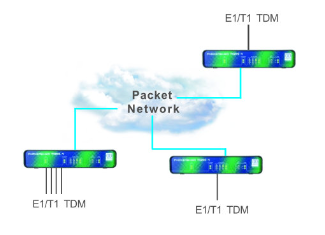TDM over IP: Bridging the Gap Between Legacy Telephony and IP Networks
Introduction
In the world of telecommunications, the convergence of traditional Time Division Multiplexing (TDM) technology with Internet Protocol (IP) networks has opened up new possibilities for efficient and cost-effective voice communication. It allows businesses to leverage the benefits of IP networks while still utilizing their existing TDM infrastructure. In this blog post, we will explore the concept of TDM over IP, its advantages, and how it enables the seamless integration of legacy telephony systems with modern IP networks.

I. Understanding TDM and IP Networks
Time Division Multiplexing (TDM) is a technology used in traditional telephony systems to transmit multiple voice channels over a single physical connection. TDM divides the available bandwidth into time slots, where each slot is assigned to a different voice channel. This enables simultaneous transmission of multiple voice calls over a single TDM link.
On the other hand, IP networks use packet-switching technology to transmit data over the internet. In an IP network, voice calls are digitized, packetized, and transmitted as data packets using the Internet Protocol. IP networks are highly flexible, scalable, and offer various services beyond voice communication, such as data and multimedia transmission.
II. The Bridge Between Technologies
It is a technology that allows businesses to transport TDM-based voice traffic over IP networks. It involves the conversion of TDM voice signals into IP packets, which can then be transmitted over an IP network infrastructure. At the receiving end, the IP packets are converted back into TDM signals for delivery to the traditional telephony system.
The key component in TDM is the TDM gateway. The gateway acts as an interface between the TDM and IP networks, performing the necessary conversion between the two technologies. It receives TDM voice signals, converts them into IP packets, and transmits them over the IP network. At the receiving end, another TDM gateway converts the IP packets back into TDM signals for delivery to the traditional telephony system.
III. Advantages
It offers several advantages for businesses seeking to modernize their communication infrastructure while preserving their investment in legacy telephony systems:
a) Cost Savings: TDM allows businesses to leverage their existing TDM infrastructure while utilizing the cost-effective benefits of IP networks. It eliminates the need for costly upgrades or replacements of legacy telephony equipment.
b) Scalability: IP networks are highly scalable, allowing businesses to easily add or remove voice channels as per their requirements. it enables businesses to scale their voice communication capacity without the limitations imposed by traditional TDM systems.
c) Flexibility and Integration: They enables the integration of voice communication with other IP-based services, such as video conferencing, unified communications, and collaboration tools. It provides businesses with the flexibility to adopt advanced communication technologies while seamlessly integrating them with their existing telephony systems.
d) Network Consolidation: They helps businesses consolidate their voice and data networks, reducing the complexity and maintenance costs associated with managing separate networks. It simplifies network management and streamlines communication infrastructure.
e) Geographical Flexibility: It enables businesses to connect geographically distributed locations seamlessly. It eliminates the need for dedicated point-to-point TDM connections between sites and allows voice traffic to be transmitted securely over IP networks.
IV. Implementation Considerations and Challenges
While IP offers significant advantages, there are a few considerations and challenges to be aware of during implementation:
a) Network Quality and Reliability: IP networks are susceptible to packet loss, latency, and jitter, which can affect voice quality. Implementing quality of service (QoS) mechanisms, such as prioritization and bandwidth allocation, is crucial to ensure reliable and high-quality voice communication.
b) Compatibility and Interoperability: TDM implementation requires compatibility between the TDM and IP networks. The selection of TDM gateways and IP network equipment should consider interoperability to ensure seamless integration.
c) Security: VoIP networks are susceptible to security threats, such as unauthorized access, eavesdropping, and denial-of-service attacks. Implementing robust security measures, including encryption, authentication, and intrusion detection systems, is essential to protect voice communication.
d) Transition Strategy: Businesses should carefully plan their transition strategy from legacy telephony systems to TDM over IP. This may involve a phased approach, where specific locations or departments are migrated gradually to minimize disruption.
Conclusion
It provides businesses with a solution that bridges the gap between legacy telephony systems and modern IP networks. It offers cost savings, scalability, flexibility, and integration possibilities, allowing businesses to leverage the benefits of IP networks while preserving their investment in TDM infrastructure. As technology continues to evolve, It remains a viable option for businesses seeking to modernize their communication infrastructure without undergoing acomplete replacement of existing telephony systems. However, it’s important to consider factors such as network quality, compatibility, security, and transition strategy during implementation. By embracing businesses can unlock the potential of IP networks while maintaining the reliability and functionality of their legacy telephony systems in the ever-changing landscape of modern telecommunications.
